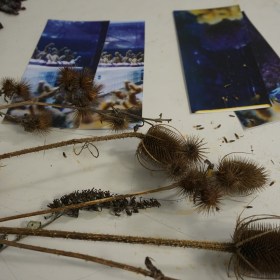Foad Alijani, Masanori Matsuda, Jolene Mok, Sarasija Subramanian & Michael Geddis as Artists in Residence – Nov – December 2017
Iranian artist Foad Alijani should have been artist in residence together with Matsuda, Geddis, Mok and Subramanian. However, due to his not be granted a visa, he was sadly unable to be in Connemara for that period of time. Alijani, not to be defeated, decided to carry out his project anyway. With the help of Marie Louise Heffernan of The Ecology Centre, we were able to support his project and supply him with information he needed about medicinal herbs in Ireland, and those common to both Iran and Ireland Alijani writes:
“Art is accomplished through the interaction of the human kind, as the artist seeks his need to discover himself. In the visual arts there is an ongoing dialogue between images and the material world. My personal approach artistically is an imitation of creation, consisting of a beginning, a path and finally the art work. My idea is to be able to keep the balance between these three parts. I truly believe that the path is the peak of all art works. The coexistence of knowledge of the universe’s entity and the interaction of all inside and outside made possible. This path is everlasting”
The work of Japanese Masanori Matsuda is all about the light. This gentlest of men arrived here from Japan in early in November, namely the darkest month of the year as it lies between Autumn Equinox and Winter Solstice. As we all know, sunlight is precious during the month of November, and Masanori was keen to ‘put focus on the quality and trajectory of sunlight during this very month for the development of [his] work.’
‘Meanwhile, I am fascinated by the way Celtic spirituality is highly connected and influenced by sunlight and darkness. While November is the darkest month, I find the Irish saying of which ‘the veil between the two worlds – the death and the alive – is very thin in November’ astounding.
The slightly uncanny definition of the close distance between different worlds in Irish culture became a major inspiration in my thinking process. I hope to evolve my work basing on the idea of seeing through a thin veil that binds the two worlds, sunlight, darkness, time and space together.’
Indian artist Sarasija Subramanian describes her engagement with found natural objects and aspects of the natural world as resulting in assemblages in a ‘quasi-archival format.’ As an artist engaged in the intersections of science, political histories and presents, mythology and folklore, she re-positions information that would otherwise be lost, misplaced or forgotten, using a combination of photography, drawings and found objects to create open-ended spaces of discourse. Having spent six weeks engrossed in a combination of science through the eyes of a coral farm and hatchery in Inagh, the Dublin Botanical Garden, and readings of Celtic myths and Irish folklore, her current project is a ‘dialogue between contradictory modes of knowledge and how they validate and disprove each other’s sanctity’ She has been documenting the coral farm through drawings and photographs, ‘In the context of man’s intervention and the consequent adaptation of nation to such interventions,’ looking in parallel at Celtic myths of Sea Monsters.
Belfast based artist, Michael Geddis was brought up in a small seaside town on the East coast of Ireland and spent his teenage holidays lobster potting and picking, drying and selling edible seaweeds. Specialising in finely detailed drawing, he delights in the elegant beauty of natural forms. In his aim to generate visually compelling artwork that incorporates a discernibleconceptual watermark, he melds macroscopic and microscopic patterns from nature and finds tiny microscopic structures particularly inspirational.
As a veterinary surgeon in his past life, Michael did a lot of orthopaedic work. He has, therefore, an informed appreciation of the innovative use of coral in assisting bone healing including the major benefits of its unique absorbable natural properties. He was delighted, therefore, when some of the team at Inagh shared beautiful electron microscope images of coral skeletons with him. Some of these feature amazing close-up shots of human bone growth cells making themselves at home on the inviting surface of the coral. New work is sprouting abundantly from this highly fertile creative environment, and it is inspiring to see his focus, as he dons his microsurgeons magnifying loupes to produce incredibly intricate drawings.












